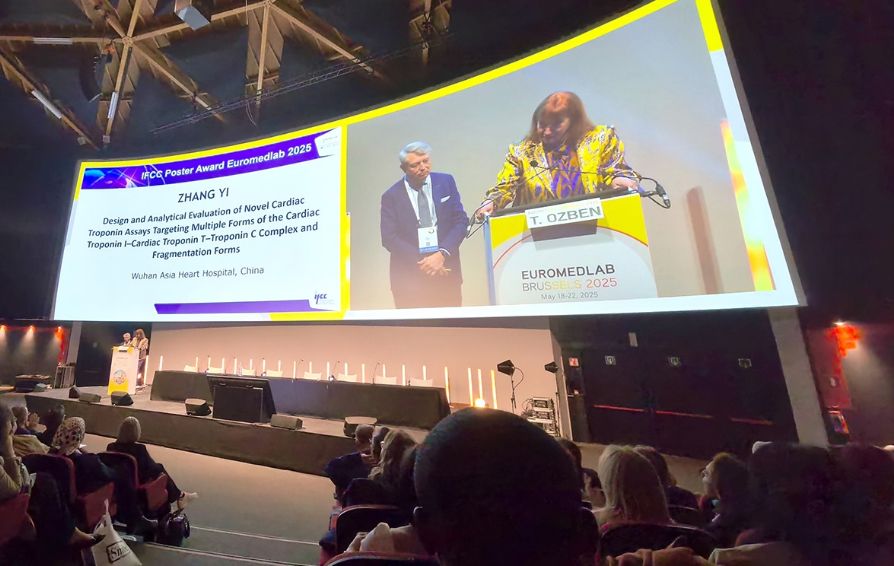IFCC President Tomris Ozben unveiled the new Young Scientists Poster Award at the 26th IFCC EUROMEDLAB Conference, marking its first presentation.
As the audience awaited the result in a dimly lit venue, the certificate appeared on the screen, casting light across the entire hall. The only "Young Scientists Poster Award" was presented to Dr. Zhang Yi from Mindray, whose team studied cardiac troponin fragmentation.

A Medical Pioneer's Calling Unlocks New Cardiac Insights
"Myocardial therapy is a race against the clock, where every second counts for life."
Dr. Zhang Yi still remembers why he and his team started in the first place — seeing anxious faces waiting in the long line outside the emergency department, he realized that emergency care was a race against the clock. Acute myocardial injury, a leading cause of death in the emergency department, must be detected accurately at critical moments. This is why they started their research on the high-sensitivity cardiac troponin fragmentation assays.


Cardiac troponin (cTn), a test marker capable of "defining" a disease, is a leading marker in medical diagnostics.
After over 30 years of evolvement, high-sensitivity cardiac troponin (hs-cTn) has been recommended as a level I marker in clinical guidelines globally and has become the "gold standard" for diagnosing myocardial infarction. As per the fourth universal definition of myocardial infarction, a patient is defined as having acute myocardial infarction when hs-cTn levels exceed the gender-specific 99th percentile upper reference limit (URL), show dynamic changes, and there is clinical evidence of ischemia. Currently, emergency situations (such as hospitalization due to acute chest pain) require continuous cTn monitoring, which prolongs the diagnosis process and reduces departmental turnover efficiency.
Professor Kristin Moberg Aakre
Chair of the IFCC Committee on Clinical Applications of Cardiac Biomarkers
An assay that can differentiate between acute and chronic myocardial injuries can help clinicians identify acute myocardial injury more quickly. With greater specificity than current strategies, it also reduces the need for repeated blood sampling during acute cardiac events.
Therefore, there is an urgent need for more straightforward and efficient methods to differentiate between acute and chronic myocardial injuries in clinical practice.
Exploring Breakthroughs in Cardiac Diagnostics
The existing hs-cTn assays are organ-specific but lack disease specificity. Therefore, an elevated hs-cTn level cannot distinguish between the various underlying causes of myocardial injury.
To unravel the underlying mechanisms of acute and chronic myocardial injuries, it is important to acquire more granular information about the nature of myocardial injury. Combining different cTn fragments makes it easier to identify the differences between acute and chronic myocardial injuries.
Previous studies have identified differences in some cTn circulating forms in samples from patients with acute and chronic myocardial injuries. However, further research shows that cTn exists in multiple complex forms rather than a single, uniform state. The assays currently used in clinical practice are not effective at distinguishing different forms of cTn fragments.
Dr. Zhang Yi
Manager of Mindray Immunoassay R&D Department
Four years ago, while developing Mindray cardiac markers, we engaged with worldwide experts and quickly identified the key clinical challenges in emergency triage, as well as the significant potential of troponin fragments.
Following consultations with leading experts, the Mindray team garnered insights from authorities including Professor Zhang Zhenlu, Director of the Clinical Laboratory Department at Wuhan Asia Heart Hospital and Professor Fred S. Apple, a preeminent U.S. specialist in cardiac troponin. Drawing on these insights and HyTest’s decades of results in basic research and high-performance antibodies, the team developed a rigorous design and conducted performance studies for assay development.
After a series of experiments, the research team was excited to find that the complete cTn fragment in long-T ITC may be rapidly released in the early stages of acute myocardial injury, while in chronic myocardial injury, the cTn present in the patient's body is mainly in the form of free cTnT fragments.
Combining different fragments presents a promising strategy for effectively differentiating between acute and chronic myocardial injuries, which will potentially advance the rapid diagnosis and treatment of myocardial infarction.
Guarding the Future of [Heart]
The award-winning report "The Potential Value of Cardiac Troponin Fragments in Identifying the Causes of Myocardial Injury" at the IFCC-EFLM EUROMEDLAB represents a key milestone in the hs-cTn research, a collaborative effort between Mindray’s R&D team and Professor Zhang Zhenlu from Wuhan Asia Heart Hospital, with contributions from Professor Fred S. Apple and Professor Ivan Katrukha at HyTest.
Recently, the team has published two relevant papers in Clinical Chemistry, the world's leading journal for in vitro diagnostics.

Dr. Zhang Yi anticipates that the collaborative, in-depth research on cTn can facilitate the identification of risks associated with acute cardiovascular disease and reduce the need for long-term patient monitoring. He envisions that, in the future, just one sample will be enough to diagnose the disease, so acute patients get surgical treatment quickly and clinical resources can be allocated more efficiently.
At this top academic conference in Brussels, the "heart" of Europe, where experts from over 100 countries gathered, Mindray won the first and only IFCC Young Scientists Poster Award. This is a big recognition from the international academic community for the progress Mindray and the R&D team at Wuhan Asia Heart Hospital have made in cTn research. It also highlights Mindray's leadership in chemiluminescence technology and serves as a great encouragement for young Chinese scientists working hard to improve human health.
Yet, there is still a long way to go before it can be used clinically to benefit patients. Building on the current research findings, Mindray's R&D team will bring together more experts from around the world to conduct multi-faceted research, bridging the gap between science and clinical practice. Their goal is to push the boundaries of what's possible in global laboratory testing and ultimately benefit more lives.
Yan Huawen
Vice President of Mindray
We believe that research will keep driving clinical applications, and in turn, clinical applications will fuel research. This mutual promotion will help build a stronger and more dynamic ecosystem in the healthcare and IVD fields.



